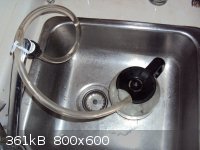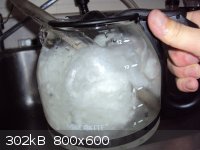mewrox99
Hazard to Others
  
Posts: 321
Registered: 7-6-2010
Location: New Zealand
Member Is Offline
Mood: No Mood
|
|
Nitrocellulose
Hello.
I am making nitrocellulose from H2SO4 and KNO3.
The potassium nitrate is slightly clumped and claims to be lab grade. The sulfuric acid is technical grade but colorless.
When 20g KNO3 is added to 40ml of ice cold H2SO4, the solution gets hot with the expulsion of Nitrogen Dioxide gas. Is this normal?
When cotton is added, it instantly blackens, followed by steam and NO2.
My guess is that it's either an impurity in the nitrate or I'm doing an inadequate job on getting the temperature under controlled.
I have made Nitrocellulose from HNO3/H2SO4 with out problems.
Thanks.
[Edited on 7-18-2011 by Polverone]
|
|
|
Formatik
National Hazard
   
Posts: 927
Registered: 25-3-2008
Member Is Offline
Mood: equilibrium
|
|
There you go.
Nitrocellulose made from KNO3/H2SO4 is less stable than that made by proper mixed acid. It's probably not something you would want to use even if you
got the nitration to work.
|
|
|
mewrox99
Hazard to Others
  
Posts: 321
Registered: 7-6-2010
Location: New Zealand
Member Is Offline
Mood: No Mood
|
|
I can get Conc. Nitric Acid, pretty cheap too (5L for $60 inc ship)
I'm just a bit reluctant to have 5L of HNO3 in my house. I have 5L of H2SO4 but at least that doesn't fume
|
|
|
Mumbles
Hazard to Others
  
Posts: 436
Registered: 12-3-2003
Location: US
Member Is Offline
Mood: Procrastinating
|
|
It sounds to me like a temperature issue. If you're making NO2 while simply mixing the nitrate and sulfuric acid together, you're not doing it right.
Add the nitrate slowly, with stirring and constant cooling. Really, if it even approaches room temperature, you're going too fast. It's going to
fume, and smoke a little bit (primarily nitric acid gases IIRC), but keep it cold. Once it's all added you're going to practically have a nitrating
paste. Mix in the cotton slowly again. It doesn't take long with cellulose. You'll have to work it in with a glass stir rod. It will still be a
paste, and pretty much a mess. Let it warm to room temperature, and stir every 10 minutes or so for maybe 45min to an hour, and wash it thoroughly.
This should go without saying, but make sure you have pure cotton. Some cotton balls or makeup pads, have plastics, or other synthetic fibers that
will melt and turn black and smoke exactly as you've described.
|
|
|
zed
International Hazard
    
Posts: 2285
Registered: 6-9-2008
Location: Great State of Jefferson, City of Portland
Member Is Offline
Mood: Semi-repentant Sith Lord
|
|
Ah, Nitrocellulose. Beautiful stuff. All sorts of lovely things used to be fashioned out of it.
I once gave my mother a fine old set of brushes and mirrors that I assumed were made of ivory, they surely appeared to be.
One day, via a cigarette smoking mishap, the large handmirror, caught fire. It was actually crafted from nitrocellulose. Mom wasn't harmed; she
threw the mirror unto the floor. The floor was harmed however; the burning handmirror could not be extinguished. It burned itself right into the
wood, and started IT on fire.
The outline of that handmirror, was "branded" into the floor, about a half-inch deep.
Good thing that folks were around.
[Edited on 12-6-2010 by zed]
[Edited on 12-6-2010 by zed]
|
|
|
mewrox99
Hazard to Others
  
Posts: 321
Registered: 7-6-2010
Location: New Zealand
Member Is Offline
Mood: No Mood
|
|
Quote: Originally posted by Mumbles  |
This should go without saying, but make sure you have pure cotton. Some cotton balls or makeup pads, have plastics, or other synthetic fibers that
will melt and turn black and smoke exactly as you've described. |
Thanks for the tips. I believe the problem was that I added the KNO3 waaaaaay to fast. I will try it next time small amounts with stirring. The cotton
balls say on the packed that there 100% cotton but who knows.
I
|
|
|
Hennig Brand
International Hazard
    
Posts: 1284
Registered: 7-6-2009
Member Is Offline
Mood: No Mood
|
|
I like nitrocellulose, it makes a nice deflagration demonstration (I actually got to do some demonstrations in front of one of my classes at school
last year). I also have a 50 calibre black powder cannon that I sometimes use homemade NC in as well. Just 3 or 4g of high nitrogen content NC in the
cannon and a lead ball can easily blow a hole through 3-4 inches of good hardwood when fired.
Anyway, I just made a batch last night.
Reactants and reagents:
1. 160mL 90% H2SO4
2. 9.6g Unbleached, pure cotton-cotton balls
3. 73.6g Dry NH4NO3
Nitrated for 15 hours at ~9C with occasional mixing
Yield: Haven't got that far yet (still rinsing), but if proportional to the last few syntheses yield will be ~17g.
I made what I think is a nice little set-up for flushing the NC of residual acid. It is not complicated but it seems to do a good job of rinsing the
NC.
 
|
|
|
anonymous201
Harmless

Posts: 31
Registered: 21-10-2011
Location: Spain
Member Is Offline
Mood: No Mood
|
|
Synthesis and Properties of Nitrocellulose
http://www.youtube.com/watch?v=mijY038xfUs
Synthesis database: Nitrocellulose synthesis
http://www.amasci.net/syntheses/nitrocellulose-synthesis.php...
|
|
|
Bot0nist
International Hazard
    
Posts: 1559
Registered: 15-2-2011
Location: Right behind you.
Member Is Offline
Mood: Streching my cotyledons.
|
|
I think the key to being successful with the acid/salt method is just a few little tricks. I like to pre-dry all reactants and sift my salt before
mixing. The "Double Dip" trick also gives a great fast burning cellulose that leaves no residue. I have l always have more luck with ammonium nitrate
than with potassium nitrate. I think partially because of both solubility and viscosity issues. It is also important to make sure all the salt is
dissolved (elevating the temp gently really helps speed the addition of the salt, and the actual nitration: >25C) and that the mix is agitated
periodically.
I had several very good and consistent batches from <a href="http://www.sciencemadness.org/talk/viewthread.php?tid=17443#pid221132">this
procedure.</a> The whole thread is pretty good if your interested in cellulose nitrate.
[Edited on 22-10-2011 by Bot0nist]
[Edited on 22-10-2011 by Bot0nist]
U.T.F.S.E. and learn the joys of autodidacticism!
Don't judge each day only by the harvest you reap, but also by the seeds you sow.
|
|
|
Hennig Brand
International Hazard
    
Posts: 1284
Registered: 7-6-2009
Member Is Offline
Mood: No Mood
|
|
@anonymous201
That synthesis database you linked to is really interesting.
I find when nitrating NC with AN nitration proceeds much more slowly than when using HNO3. I usually nitrate for 3-4 hours at room temperature when
using AN as the source of nitrate, but this time the temperature was lower and I just wanted to see how a longer nitration time would affect the
results.
I normally use a couple of water rinses followed by a thorough washing in a sodium bicarbonate solution however, this time I wanted to do a very
thorough rinsing instead with no alkali. I have a theory that the alkali may not do the NC any good (I read something somewhere a while back).
@Bot0nist
Yeah, I may have done a bad thing by keeping the nitration temperature at ~9C. I hope that the longer nitration time made up for it. It just so
happened that the ambient temperature outside right then was ~9C. We will find out soon if the NC is highly nitrated or not.
Something I would like to note. Sulfuric acid when heated will start to give off white fumes below 90% concentration I believe, so this is not a good
indication that the acid is highly concentrated.
I like using AN better than KNO3 as well for this nitration.
Edit: (the next day)
Well on weighing the dry product I found that my yield is a little low at 15.5g. I calculated that my yield would have been ~16.5g if the yield was
proportional to the yield from my last experiment where I nitrated for 3-4 hours at >20C.
I think it would be hard to judge the exact level of nitration by weight though as cotton wool is an irregular material. It is definitely highly
nitrated, an opinion based on observation of the deflagration. Though highly nitrated the material doesn't seem to have quite the whomp when lit that
it should, just another observation. I suppose there are scientific ways to test for the level of nitration, maybe I should look into it.
When using the AN method I will nitrate cotton at >20C if possible from now on.
[Edited on 23-10-2011 by Hennig Brand]
|
|
|
Hennig Brand
International Hazard
    
Posts: 1284
Registered: 7-6-2009
Member Is Offline
Mood: No Mood
|
|
After doing a casual search there doesn't seem to be much information which would indicate that a mild sodium bicarbonate solution should degrade
nitrocellulose significantly. In fact mostly what I found were examples where sodium bicarbonate was recommended in a nitrocellulose synthesis to
neutralize residual acidity. I did find a pdf of a report based on intentional alkaline hydrolysis of nitrocellulose using sodium hydroxide, but there
is a big difference between the strength of sodium hydroxide and sodium bicarbonate. I will include the pdf for others to take a look at.
In a lot of the old explosive books they described rinsing the nitrocellulose with water until it was free of acid. Was this just to save expensive
alkali?
Attachment: NC alkaline hydrolysis.pdf (389kB)
This file has been downloaded 1119 times
|
|
|
Bot0nist
International Hazard
    
Posts: 1559
Registered: 15-2-2011
Location: Right behind you.
Member Is Offline
Mood: Streching my cotyledons.
|
|
I imagine. I rinse and flush like crazy, and when I finally add the bicarbonate solution to sit over night I notice very little fizzing.
U.T.F.S.E. and learn the joys of autodidacticism!
Don't judge each day only by the harvest you reap, but also by the seeds you sow.
|
|
|
Hennig Brand
International Hazard
    
Posts: 1284
Registered: 7-6-2009
Member Is Offline
Mood: No Mood
|
|
I noticed basically the same thing. With small batches it is easy to do a good job of rinsing. In fact, I have noticed many times that there was no
effervescence at all when the rinsed NC was put into the bicarb solution.
I tried another batch with the same cotton, acid and nitrate and in the same ratios but this time instead of nitrating for 15 hours at 9C I did the
usual 4 hours at room temperature (which happened to be 23C). I got almost an identical yield proportionately.
15 hour nitration at 9C:
9.6g cotton in/15.5g NC out
4 hour nitration at 23C:
5.2g cotton in/8.5g NC out
I guess one or more of my reactants is probably the nitration level limitation. I guess I could try a longer nitration time (double perhaps) at room
temperature and see if I get a different result.
[Edited on 24-10-2011 by Hennig Brand]
|
|
|